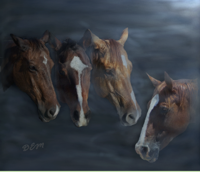
Walk
[As additional resources, links to book reviews and book purchasing information can be found beneath the quotations when this information is available.]
"It is important that a horse should walk with long, regular and free steps, which can be obtained only by allowing the animal great liberty of head and neck."
James Fillis, Breaking and Riding
Buy Book
(Top)
"To follow the horse's back at the walk, you must have a deep, mobile receiving seat."
Sally Swift, Centered Riding
Read Review
Buy Book
(Top)
"There is a fine line between allowing your horse to slide your seat bone and your pushing. Try not to push. A generous slide will enhance your soft receiving and following seat. You will feel your horse expand his stride, reaching his hind feet well forward with each swinging step."
Sally Swift, Centered Riding
Read Review
Buy Book
(Top)
"To shorten the stride, simply reduce your activity. Do not become rigid, just less active."
Sally Swift, Centered Riding
Read Review
Buy Book
(Top)
"Using trot work as a gymnastic exercise greatly improves the walk."
Jane Savoie, Cross-Train Your Horse, Simple Dressage for Every Sport
Read Review
Buy Book
(Top)
"Debby [Sabin of Lovelane Special Needs Horseback Riding Program] explains that when a horse walks, the movement felt through the person's hips is almost identical to the human gait and provides the feeling of normal walking."
Jane Savoie, Cross-Train Your Horse, Simple Dressage for Every Sport
Read Review
Buy Book
(Top)
"It's very easy to ruin a horse's natural walk if he feels confined."
Jane Savoie, Cross-Train Your Horse, Simple Dressage for Every Sport
Read Review
Buy Book
(Top)
"...the horse's back is highest at the walk when its hind legs are directly under it pelvis. This happens twice every walk stride."
Kathleen Schmitt, The Seamless Seat
Read Review
Buy Book
(Top)
"...we can use the walk to train our sensory systems to tell us what we can't see about the horse's movement when we are in the saddle."
Kathleen Schmitt, The Seamless Seat
Read Review
Buy Book
(Top)
"The walk is unique in a few ways. It is the only gait with no phase of suspension. The horse always has two or three legs on the ground, so the horse is least likely to lose its balance at the walk."
Kathleen Schmitt, The Seamless Seat
Read Review
Buy Book
(Top)
"...the walk is more useful to teach the rider some things than it is for gymnasticizing a horse."
Kathleen Schmitt, The Seamless Seat
Read Review
Buy Book
(Top)
"The most common fault of the correctness of the footfall at the walk is a pacey walk, sometimes called a camel walk, in which the lateral pairs of legs touch down almost at the same time instead of in distinctly separated beats. This makes a walk, rhythm of 1, 2...3,4, instead of a clear, even beat for each foot: 1, 2, 3, 4."
Kathleen Schmitt, The Seamless Seat
Read Review
Buy Book
(Top)
"Another common gait fault at the walk is jigging, when the horse tosses in a few trot-like steps here and there."
Kathleen Schmitt, The Seamless Seat
Read Review
Buy Book
(Top)
"Quiet walk work is a regular part of good retraining."
Dr. Gerd Heuschmann, Balancing Act
Read Review
Buy Book
(Top)
(Top)